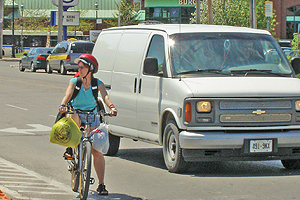Part B: The Road Safety Audit Process
7.0 Post-construction Road Safety Audits
RSAs in the post-construction phase (referred to here as an RSA of existing roads) will have a different focus from a traditional safety review or investigation of crash history.
7.1 RSA of Existing Roads
Traditional safety reviews and investigations of crash history rely primarily on crash data to determine what safety issues are occurring at the site. They are reactive as they mainly identify safety issues after a crash or pattern of crashes have occurred and are often initiated in response to an unusually high number of crashes occurring along a section of road or at a particular intersection or interchange.
What is the purpose of an RSA on existing roads?
- Evaluate all roadway and roadside features, design elements and local conditions (glare, night visibility, adjacent land uses, etc.) that would increase the likelihood and severity of a crash.
- Review firsthand the interaction of the various design elements with each other and the surrounding road network.
- Observe how road users are interacting with the road facility.
- Determine if the needs of all road users have been adequately and safely met.
- Explore emerging operational trends or safety issues at that location.
In contrast, RSAs of existing roads rely mainly on the site visit, as-built design drawings (if kept up to date), and other project data (e.g., previous reports) to determine what safety issues are expected to arise at the site. This will provide the RSA team with an accurate picture as to the level of safety on the road. For this reason, RSAs are proactive as they can identify where crashes will likely occur and what will be their resultant severity. Crash data, if available, should be used to supplement any findings made as a result of the site visit and review of project data. However, the RSA team may choose not to examine the crash history until after the project data review and site visit have been completed so that their evaluation is not biased by the crash data. Also, crash data is often dated and does not always help in determining emerging operational trends or safety issues at a location.
The following project data may be provided to/requested by the RSA team:
- As-built design drawings (noting whether these accurately reflect existing conditions).
- Previous crash investigations conducted.
- Crash data (by location, crash type, and severity).
- Volume data.
- Speed data.
- Signal timing plans (if applicable).
- Roadway functional classification.
- Existing policies, standards, and guidelines.
- Previous audit reports.
Range of scope for existing road RSAs.
RSAs of existing roads may vary in scope. Three different, commonly-conducted types of RSAs on existing roads are as follows:
- RSAs of specific locations.
- RSAs of an entire highway section, freeway section, or road network.
- RSAs of a specific feature or design element within an entire highway section, freeway section, or road network.
Observing driver behavior during the field visit.
When conducting RSAs of existing roads, the RSA team will have the advantage over pre-construction and construction phase audits in that they may not only observe the various road features and how they complement each other but also see how road users are interacting with the road facility. They may observe incidents of driver behavior that suggest something inherently wrong, misleading, or absent in the road design. Vulnerable road users (e.g. elderly drivers or pedestrians, visually impaired pedestrians, children) may be observed having particular difficulty negotiating through a site being investigated. Alternatively, they may observe motorists committing traffic offenses (e.g. excessive speed, red light running, failing to yield to pedestrians) and may suggest an enforcement or education-based treatment.
Examining physical evidence of past crashes and off-road excursions.
Another advantage of conducting RSAs of existing roads over RSAs in the pre-construction or construction phase is the RSA team's ability to observe physical evidence of past crashes and off-road excursions, such as:
- Damage to curbs, roadside barriers, trees, utility poles, delineator posts, and signs.
- Scuff marks on curbs and concrete barriers.
- Skid marks, broken glass, oil patches on the road.
- Vehicle tracks or rutting in the ground adjacent to a roadway
Such evidence will assist in diagnosing possible areas of elevated safety risk. Where damage has occurred such that a roadside feature has been compromised, this should be noted and reported in the audit as a maintenance concern.
For RSAs of existing roads, unless otherwise directed by the project owner, all roadway and roadside features or elements are to be considered as within the scope of the RSA , as in a detailed design stage RSAs.
Another feature of RSAs of existing roads is that, at the outset, the RSA team will want to consider whether the road facility under review has the same function and classification as it did when it was originally designed and constructed. Changes in traffic volume, vehicle mix, increased presence of vulnerable road users, or adjoining land use developments may have rendered the original classification and design of the facility obsolete. Standards, policies and guidelines may be a starting point for the RSA team in identifying roadway/roadside elements or features that are no longer consistent with the function and classification of the road, and are potentially posing a risk to road users.


